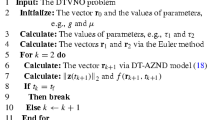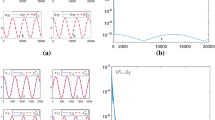Abstract
In this work, a discrete-time noise-tolerant Zhang neural network (DTNTZNN) model is proposed, developed, and investigated for dynamic matrix pseudoinversion. Theoretical analyses show that the proposed DTNTZNN model is inherently tolerant to noises and can simultaneously deal with different types of noise. For comparison, the discrete-time conventional Zhang neural network (DTCZNN) model is also presented and analyzed to solve the same dynamic problem. Numerical examples and results demonstrate the efficacy and superiority of the proposed DTNTZNN model for dynamic matrix pseudoinversion in the presence of various types of noise.







Similar content being viewed by others
References
Arqub OA (2017) Fitted reproducing kernel Hilbert space method for the solutions of some certain classes of time-fractional partial differential equations subject to initial and Neumann boundary conditions. Comput Math Appl 73(6):1243–1261
Arqub OA, Abo-Hammour Z (2014) Numerical solution of systems of second-order boundary value problems using continuous genetic algorithm. Inf Sci 279(20):396–415
Arqub OA, Momani S, Al-Mezel S, Kutbi M (2017) A novel iterative numerical algorithm for the solutions of systems of fuzzy initial value problems. Appl Math Inf Sci 11(4):1059–1074
Courrieu P (2005) Fast computation of Moore–Penrose inverse matrices. Neural Inf Process Lett Rev 8(2):25–29
Cretu AM, Chagnon-Forget M, Payeur P (2017) Selectively densified 3D object modeling based on regions of interest detection using neural gas networks. Soft Comput 21(18):5443–5455
Feldkamp LA, Puskorius GV (1998) A signal processing framework based on dynamic neural networks with application to problem in adaptation, filtering, and classification. Proc IEEE 86(11):2259–2277
Guo W, Huang T (2010) Method of elementary transformation to compute Moore–Penrose inverse. Appl Math Comput 216(5):1614–1617
Guo D, Zhang Y (2014) Zhang neural network for online solution of time-varying linear matrix inequality aided with a equal conversion. IEEE Trans Neural Netw Learn Syst 25(2):370–382
Huang F, Zhang X (2006) An improved Newton iteration for the weighted Moore–Penrose inverse. Appl Math Comput 174(2):1460–1486
Jin L, Zhang Y (2014) Discrete-time Zhang neural network of \(O(\tau ^3)\) pattern for time-varying matrix pseudoinversion with application to manipulator motion generation. Neurocomputing 142(22):165–173
Jin L, Zhang Y, Li S (2016) Integration-enhanced Zhang neural network for real-time-varying matrix inversion in the presence of various kinds of noises. IEEE Trans Neural Netw Learn Syst 26(12):2615–2627
John M, Kurtis F (2004) Numerical methods using MATLAB, 4th edn. Prentice Hall, London
Juang L, Wu M (2010) Image noise reduction using Wiener filtering with pseudo-inverse. Medsci 43(10):1649–1655
Kang S (2017) Outgoing call recommendation using neural network. Soft Comput. https://doi.org/10.1007/s00500-017-2946-3
Liao B, Zhang Y (2014) From different ZFs to different ZNN models accelerated via Li activation functions to finite-time convergence for time-varying matrix pseudoinversion. Neurocomputing 133(10):512–522
Liu J, Chen S, Tan X, Zhang D (2007) Efficient pseudoinverse linear discriminant analysis and its nonlinear form for face recognition. Int J Pattern Recognit Artif Intell 21(8):1265–1278
Moon HM, Seo CH, Pan SB (2017) A face recognition system based on convolution neural network using multiple distance face. Soft Comput 21(17):4995–5002
Nadeem M, Banka H, Venugopal R (2018) A neural network-based approach for steady-state modelling and simulation of continuous balling process. Soft Comput 22(3):873–887
Nemec B, Zlajpah L (2000) Null space velocity control with dynamically consistent pseudo-inverse. Robotica 18(5):513–518
Perković MD, Stanimirović PS (2011) Iterative method for computing the Moore–Penrose inverse based on Penrose equations. J Comput Appl Math 235(6):1604–1613
Tasić MB, Stanimirović PS, Petković MD (2007) Symbolic computation of weighted Moore–Penrose inverse using partitioning method. Appl Math Comput 189(1):615–640
Wang J (1997) Recurrent neural networks for computing pseudoinverses of rank-deficient matrices. SIAM J Sci Comput 18(5):1479–1493
Wang J, Jeong J (2017) Wavelet-content-adaptive BP neural network-based deinterlacing algorithm. Soft Comput. https://doi.org/10.1007/s00500-017-2968-x
Wang H, Li J, Liu H (2006) Practical limitations of an algorithm for the singular value decomposition as applied to redundant manipulators. In: Proceedings of IEEE conference on robotics, automation and mechatronics. pp 1–6
Wei Y (2000) Recurrent neural networks for computing weighted Moore–Penrose inverse. Appl Math Comput 116(3):279–287
Wei Y, Wu H, Wei J (2000) Successive matrix squaring algorithm for parallel computing the weighted generalized inverse \(A^{+}_{MN}\). Appl Math Comput 116(3):289–296
Wei Y, Cai J, Michael KN (2004) Computing Moore–Penrose inverses of Toeplitz matrices by Newtons iteration. Math Comput Model 40(1–2):181–191
Zhang Y, Leithead WE (2005) Exploiting Hessian matrix and trust-region algorithm in hyperparameters estimation of Gaussian process. Appl Math Comput 171(2):1264–1281
Zhang BL, Zhang H, Ge SS (2004) Face recognition by applying wavelet subband representation and kernel associative memory. IEEE Trans Neural Netw 15(1):166–177
Zhang Y, Li Z, Guo D, Ke Z, Chen P (2013) Discrete-time ZD, GD and NI for solving nonlinear time-varying equations. Numer Algorithms 64(4):721–740
Zhang Z, Li Z, Zhang Y, Luo Y, Li Y (2015) Neural dynamic method based dual arm CMG scheme with time-varying constraints applied to humanoid robots. IEEE Trans Neural Netw Learn Syst 26(12):3251–3262
Zhang Y, Jin L, Guo D, Yin Y, Chou Y (2015) Taylor-type 1-step-ahead numerical differentiation rule for first-order derivative approximation and ZNN discretization. J Comput Appl Math 273:29–40
Zhou J, Zhu Y, Li X, You Z (2002) Variants of the Greville formula with applications to exact recursive least squares. SIAM J Matrix Anal Appl 24(1):150–164
Acknowledgements
This work is supported by the National Natural Science Foundation of China (with numbers 61563017 and 61503152), by the Hunan Natural Science Foundation of China (with numbers 2017JJ3258 and 2017JJ3257), by the Research Foundation of Education Bureau of Hunan Province, China (with numbers 17B215 and 17C1299)).
Author information
Authors and Affiliations
Corresponding author
Ethics declarations
Conflict of interest
All authors declare that they have no conflict of interest.
Ethical approval
This article does not contain any studies with human participants or animals performed by any of the authors.
Additional information
Communicated by A. Di Nola.
Rights and permissions
About this article
Cite this article
Xiang, Q., Liao, B., Xiao, L. et al. Discrete-time noise-tolerant Zhang neural network for dynamic matrix pseudoinversion. Soft Comput 23, 755–766 (2019). https://doi.org/10.1007/s00500-018-3119-8
Published:
Issue Date:
DOI: https://doi.org/10.1007/s00500-018-3119-8




